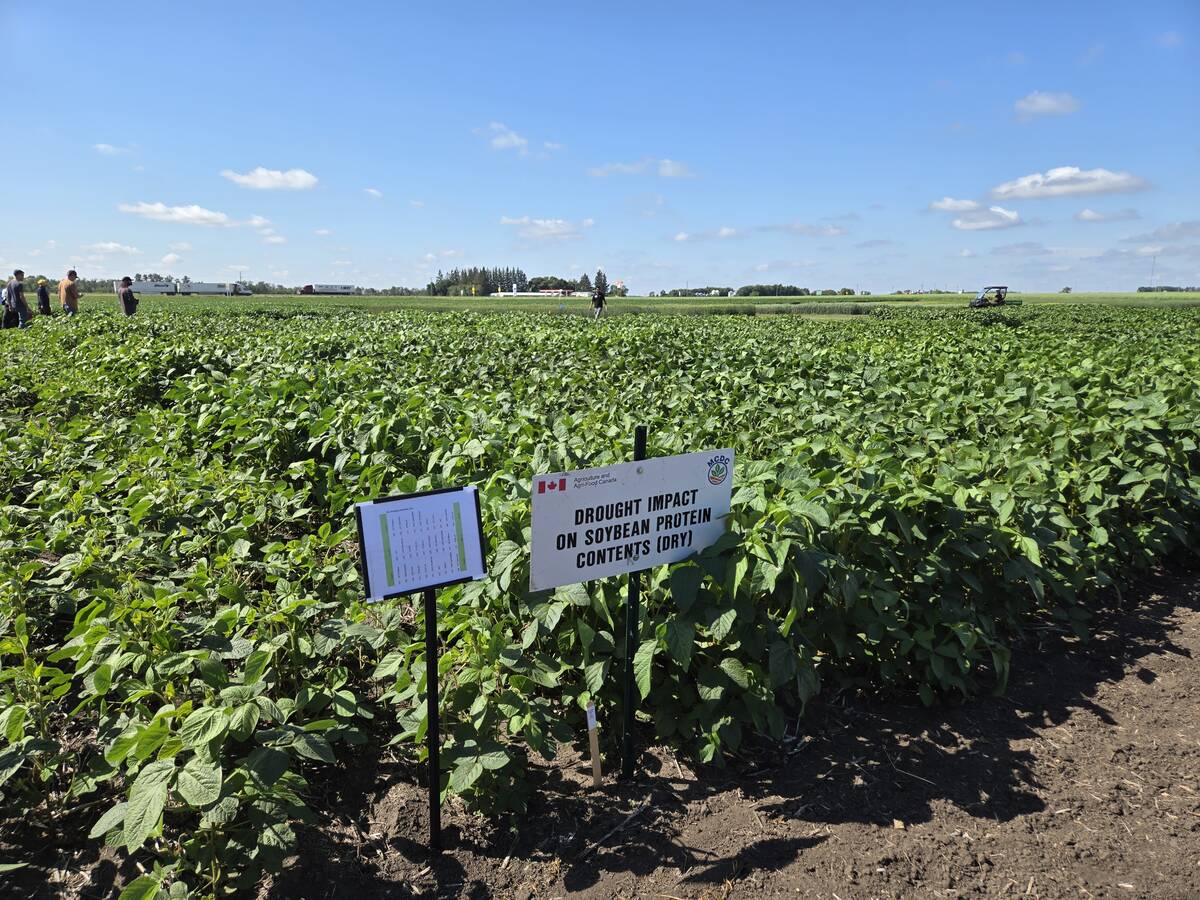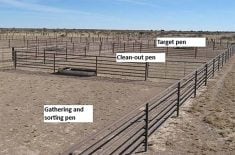KENNEDY, Sask. – The days of bringing the cattle home for the winter and confining them in corrals have been giving way to alternative feeding methods.
Judging by the response to a tour and presentations of several options in southeastern Saskatchewan, many cattle producers are weighing those options and looking for new ideas to feed all winter, or at least extend the grazing season.
About 170 people attended the event organized by the North Moose Mountain Creek Agri-Environmental Group Plan.
Kevin Dorrance of T Bar K Ranch at Wawota was an early adopter of swath grazing, using that method to feed the herd from 1990 to 2006.
Read Also

Carberry field day looks for agriculture solutions
Manitoba farmers explored research solutions for resilient crops, perpetual agronomic issues and new kinds of agricultural products at a field day at the Manitoba Crop Diversification Centre in Carberry on Aug. 6.
He told the crowd he would still do it if he had any cultivated land, but a decision to seed all their land to grass forced a change.
“We decided bale grazing was the next best thing,” he said.
His land is divided into 30-acre cells where he runs 170 cows at a time. The cows are in each cell for two to three weeks, focusing on 10 or 12 bales until they are moved.
“We do not intensively bale graze,” Dorrance sad. “I don’t want to have to be out there every two or three days.”
All the bales are in the cells at the start of the grazing period so they don’t have to be moved in cold weather.
One group of cows will be located on a summer field that was rotation-ally grazed while another will be on a hay field.
One group will eat snow all winter, a practice Dorrance said he has followed for the past 20 years, with concerns in only two of those years when there wasn’t enough snow. The other is watered through a year-round solar-powered system.
Dorrance prefers bales wrapped in mesh rather than plastic or sisal twine. He said it’s easier to clean up in spring.
He also places the bales on their sides so the cows can eat from both ends, resulting in less waste.
The Wawota area has lots of natural shelter, with bush in each of Dorrance’s grazing cells. Sloughs with cattails and portable windbreaks also offer protection.
The benefits of bale grazing include lower operating costs, no winter tractor cost and increased land fertility. Dorrance said bale grazing on a 25-year-old pasture has been just like reseeding it.
The drawbacks include the added baling and hauling operations.
However, a summary he provided shows that grazing homegrown bales on a hay field costs about $1 per cow per day, compared to $1.65 for purchasing the hay and putting it on the pasture and $1.96 for buying hay landed in the yard and hauling it to the pasture in the winter.
Dorrance, who lives near Moose Mountain Provincial Park, said elk are the biggest concern. He said they have some land against the park boundary and wouldn’t try either bale grazing or swath grazing there.
Near Estevan, Chad Ross has added corn grazing to the family’s winter feeding options.
Over the years, the Rosses have tried different methods. Thirty years ago they, like many others, fed the animals in the same place every day and bedded them there also.
Now, corn, bale and swath grazing are all used for 330 cow-calf pairs.
“I started growing corn about six years ago mainly for silage purposes when we had the feedlot,” he said.
“My goal was to get a product that I could double my production on an acre of land at the same cost per tonne.”
Ross said when he calculated the cost of hauling corn to the yard compared to the cow eating it directly, he turned to corn grazing.
Forty-acre paddocks are set off by an electric fence, with a portable wind fence and the corn providing shelter. He has also developed wells for winter watering.
The cattle spend 14 to 20 days in each paddock, depending on weather and how much feed they require for the conditions.
Each paddock is about half corn and half millet. The millet is swathed and the bales are placed between the swaths.
Ross seeds Fusion corn, a low lignin variety.
“It allows for better digestibility.”
He also said producers who plan to corn graze should have a contingency plan in case of emergency or crop failure and keep an eye on cow condition.
Advantages to corn grazing include lower costs, healthy animals and no tractors to run. He calculated his 2009-10 wintering cost at 79 cents per animal unit.
Disadvantages include the possibility of acidosis and the chance that wildlife will eat the corn.
“I tried to fight it but now I just budget them in,” he said of the deer.
Swath grazing is an efficient winter-feeding method from both cost and time perspectives, said Les Johnston of Fillmore. He swath grazes green-feed and Derby yellowfeed oats for 225 Simmental based cows.
The greenfeed is sown in late June or early July and swathed in September.
The yellowfeed is sown earlier in order to capitalize on yield potential, he said.
“We spray it at about 70, 72, 75 days. We go in with the sprayers at late milk, early dough (stage),” he said.
The crop will continue maturing for another week to 10 days as it dries, leaving the majority of it in the early dough stage by the time it stops. It is swathed in about mid-October.
Johnston said the crop doesn’t suffer from shelling while it stands. He is aiming for a bushel weight of between 25 and 30 pounds.
He said he gets about 75 days of grazing from Nov. 1 to the middle of January, using 40-acre paddocks separated by electric fence. The cattle lick snow for water.
Greenfeed and yellowfeed have increased the total digestible nutrients available and protein levels are usually higher.
The younger crop is more palatable, he said.
Disadvantages to the practice include swaths that are covered with snow or ice and unavailable until spring, wildlife damage and extra electric fence costs. The soil also needs to be firm so cattle don’t walk on the swaths and push their feed into the ground.
Johnston said he has seen less wildlife damage since using this method. When he was feeding bales stockpiled in the yard, he was losing $8,000 to $12,000 per year due to whitetail deer.
Specific advantages to yellowfeed include locking in the nutrient level at the right time, avoiding frost damage, weed control in cropped land and quality.
Johnston calculated he saves about 36 cents per head per day, when compared to feeding bales that have to be hauled from another site.
Extending the grazing season by stockpiling forage was a way for Owen Pekrul of Grenfell to cut costs and rejuvenate old forage stands.
Eighty percent of Pekrul’s 5,500 acres is either native or tame grass. Most of it is on sandy marginal soil.
His cows calve in May and are in their second trimester during the winter months. Their nutritional needs aren’t as great when the grazing isn’t as good.
“I believe the best use of stockpiled grass in my situation is in spring,” he said.
In 2002, he seeded tame forage. This year, 160 cows were in the pasture between April 15 and 23 with a straw and silage supplement.
On July 29, he took 12 tonnes per acre of silage off that same field.
The cow-calf pairs went to 100 acres of native grass, stockpiled through the growing season, from Nov. 12 to 22. Pekrul estimated 60 percent forage utilization and said the pasture would not be used again until late next year.
The cows then went back to the tame forage pasture Nov. 25 for two weeks, along with some silage supplement. He estimates the cost at 86 cents per head per day.
“Without the stockpile, we’d need an extra 30 lb. of something.”
If straw is that extra, at three cents per lb., that cost would be 90 cents per day. Pekrul calculates his savings of 160 cows grazing for 33 days in total, at 90 cents per day, at $4,752.
Other advantages include healthier soil and forage, rejuvenation without having to reseed and more options for how long and how much pastures are grazed.
“You actually have to manage it. When it’s time you actually have to move.”
He is still learning how to determine when the cattle should be moved.
Pekrul added that wildlife hasn’t been a problem even though he sees more in the pasture now.
“I believe what we’re gaining is far past what we’re losing,” he said.
Alan Whitrow’s first experience with chaff grazing wasn’t exactly a rousing success. His 110 cows were used to calving in a barn in a confined winter feeding situation.
In 2008, there was no carry-over feed and no hay production, so Whitrow decided to use the leftovers from his grain operation to feed the herd.
“Never change your management style if you’re in crisis mode,” he said.
He built a chaff box for about $200 to collect from the combine and set up electric fencing so the cattle could graze from the chaff piles.
A mid-December storm changed everything. The cows tore through the fence and he rounded them up 12 to 16 kilometres away. A week later, they did the same thing.
“We fought with them til the middle of January and then we brought them home,” said Whitrow.
Last year, things went smoothly. “It was the most beautiful thing I have ever experienced as a rancher. They were just the happiest cows.”
It cost about $2,000 to set up the electric fence, snow fence and chaff box and Whitrow estimates $200 per year in maintenance.
But the cattle are eating up to 5,000 lb. of crop residue that would otherwise be lost.
This past November, he fed 90 cow-calf pairs and 35 replacements 15 bales of unharvested lentils from 2009 and 15 alfalfa-grass bales from this year close to the yard.
“When I do feed these animals, they’re going through about five bales a day,” Whitrow said. “I’ve been feeding one bale a day.”
Calves also got four lb. of oats per day.
Whitrow said chaff grazing is a “no brainer” if fenced grain land is available. He said if chaff can get his herd through Christmas time, he believes it was a success.
He hasn’t experienced any problems with geese getting into the chaff piles.















